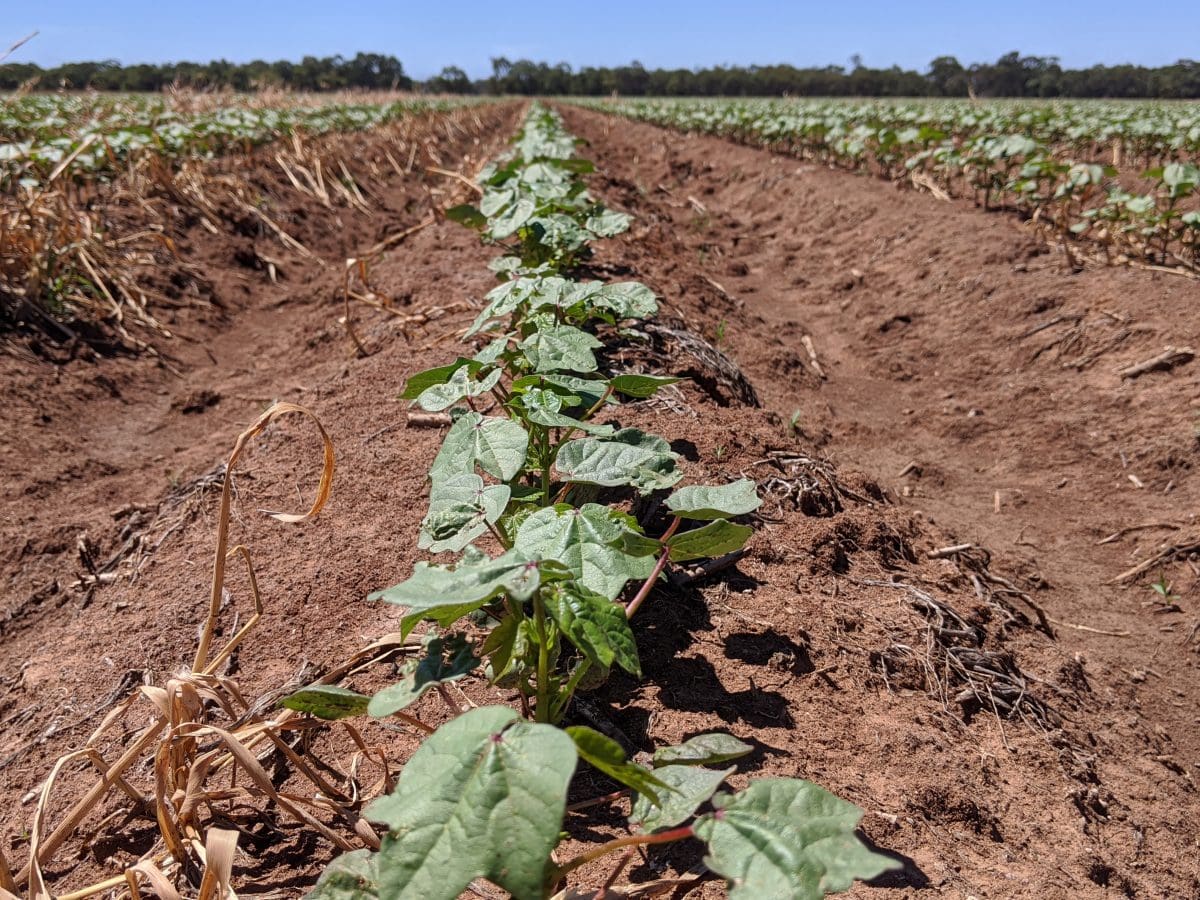
Cotton growing at the IREC Field Station in southern NSW. Photo: IREC
AUSTRALIA is on track to produce a cotton crop almost four times the size of last year’s, but still well below the long-term average, with the recent run of rain events in most growing areas helping underpin yield prospects.
The falls have also prompted a late run on planting ahead of the widely held cut-off date of 31 December.
However, with water allocations from major dams in northern New South Wales still at very low levels, and most on-farm storages nowhere near full, any upside to area is seen as limited.
Early heat weathered well
AMPS Moree-based agronomist Tony Lockrey said recent falls in the wider region had brought up to 80 millimetres of rain to cotton crops.
“A lot of people had 20-50mm; 80mm was a highlight,” Mr Lockrey said.
Harsh summers of recent years have challenged the idea that October is the ideal time to plant cotton in the Gwydir Valley, which traditionally has been one of Australia’s biggest cotton-growing regions.
“October-plant cotton tends to get smashed by the heat when it’s loaded with fruit, and more dryland tends to go in in November.
“Summers in the past few years have been so hard that we’ve pretty much forgotten how to grow a good summer crop, but we have had some handy crops with good-quality cotton planted well into December.”
Mr Lockrey said cotton had weathered the fierce heatwave of last week well.
“Of all the summer crops, it handles the heat the best.”
Rainfall in the week to 9am today has varied hugely across eastern Australia’s main cotton-growing areas from nothing to almost 100 millimetres in patches.
In New South Wales, registrations included: Gunnedah 21mm; Moree 41mm; Mungindi 13mm; Narrabri 46mm; Trangie 15mm; Walgett 17mm.
Queensland mixed
Rain Agribusiness director Ian Grellman said the limited irrigation availability for Central Queensland had seen little growth in its area planted compared with last year.
“They’ve got dam levels below what you can irrigate from, but there’s a reasonable amount of cotton on the Downs this year.”
In Queensland’s south-west, St George and Dirranbandi have seen a big increase in area following rain earlier this year which filled storages.
Registrations in Queensland include Chinchilla with 26mm, Dalby with 31mm, and Jondaryan with 9mm, but gauges in some centres including Dirranbandi, Emerald and Goondiwindi recorded nothing, and St George received a mere 0.6mm.
South improved
In the southern half of NSW, rain in cotton areas in the past week was lucky to reach double digits.
However, growers have planted a manageable amount of cotton, and are looking at much better water availability now than at this time last year.
RivCott is one of four gins operating in southern NSW.
Rivcott CEO Sam Buster said RivCott last season ginned only 33,000 bales supplied by 14 growers, while this season, it is expecting around 40 growers to supply 120,000 bales.
Its biggest ginning year to date saw 80 growers supply 300,000 bales.
“The 2021 ginning season will be 30pc of what we think is normal; last year it was 10pc,” Mr Buster said.
Recent inflows into storages on the Murrumbidgee and Murray rivers have lifted irrigation allocations for both valleys.
“The Murrumbidgee allocation is above 70pc and rising every month.
“The prediction is it will get up to 100pc, and the Murray is rising too, which means the temporary price of water has dropped.
“It’s all stacking up for a great 2022.”
Market steady
Trade sources continue to report that Chinese spinning mills are being encouraged to look to origins other than Australia for their lint.
However, Chinese-owned mills outside China are continuing to forward buy Australian lint, and merchants are showing growers prices which are relatively steady at around $500-$550 per bale.
With a tough finish to the US growing season, merchants are seeing a shortage of high-grade cotton, so Australian lint with a long, bright and strong staple is expected to sell well.
| 2019-20ha | 2020-21ha | Change | |
| Central Qld | 8,676 | 10,500 | +21% |
| Southern Qld | 6,936 | 62,000 | +894% |
| Macintyre | 1,564 | 13,750 | +879% |
| Gwydir/Bourke | 3,287 | 38,200 | +1162% |
| Namoi | 17,682 | 37,000 | +109% |
| Macquarie | 4,915 | 18,250 | +371% |
| Southern | 15,798 | 37,250 | +136% |
| TOTAL HECTARES | 58,858 | 216,950 | +369% |
| BALES | 589,656 | 2,300,000 | +390% |
Table 1: Cotton Australia (CA) area estimates for the current and previous crop with corresponding production estimates, not including area in the Northern Territory and the Ord region of Western Australia. ABARES last week in its periodic Australian crop report put Australia’s planted area at 254,000ha, or 36pc below the 10-year average to 2019-20, to produce 2.2 million bales.
Grain Central: Get our free cropping news straight to your inbox – Click here

HAVE YOUR SAY